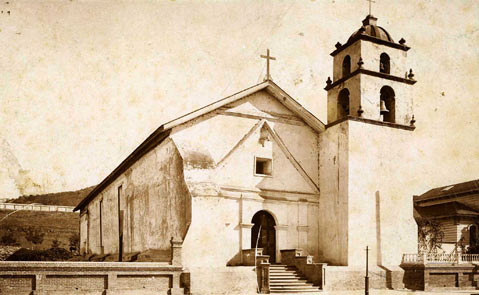The Big Earthquake of 1857
The Tejon Temblor was the Second Strongest in State History

The earthquake, which rolled through Southern California on the morning of January 9, 1857, was the second strongest in the state’s history; only the 1906 San Francisco quake was considered greater. The temblor along the San Andreas Fault ruptured the earth for more than 200 miles and was felt from San Francisco to San Diego, and from the Channel Islands in the west to the Nevada desert in the east. It also caused quite a stir in Santa Barbara.
The epicenter was located near Fort Tejon in southern Kern County. Fort Tejon had been founded in 1854 just north of where the town of Lebec is today. In November 1857, the fort would become the headquarters of the army’s Camel Corps. Troops manning the fort were drawn away with the outbreak of the Civil War in 1861, and the fort was abandoned by 1864.
The primary earthquake fault in California is the 650-mile long San Andreas Fault. It was named in 1895 after a lake on the San Francisco Peninsula and it runs from Mendocino County southward to the Salton Sea area. The two greatest quakes in the state’s history, the San Francisco and the Tejon quakes, took place along this fault.
The Fort Tejon earthquake struck a little after 8:20 a.m. The fort was very heavily damaged and for the next several weeks the soldiers stationed there would live in tents. Trees were uprooted and the current of the Kern River actually reversed course for a time. The earth opened up for some 225 miles along the fault. Near the epicenter, the violent shaking continued for approximately three minutes.
Later researchers estimated the earthquake at 7.9 on the Richter scale. In comparison, the quake that devastated Santa Barbara in 1925 was around 6.3 in intensity. Given the strength of the Tejon quake, it is remarkable that only one person died in the disaster. This was due, at least in part, to the sparse population near the epicenter and the fact that in all California there were only around 330,000 people in 1857.
Santa Barbara, with a population at that time of about 2,300, received a severe shaking. According to accounts in the city’s only newspaper, the Gazette, the quake lasted 40 to 60 seconds and caused great consternation. Townspeople rushed from their homes and many fell to their knees asking for divine intervention. Reportedly, the quake slowly built in intensity, reached a crescendo, and then died back down. The paper reported, “The peculiar motion … very much resembled that on board a vessel in a moderate sea.”
Damage was not very great. The Gazette attributed this to the solid nature of the town’s adobe construction and the fact that there were very few multi-story buildings. Even those buildings of more than one story, such as the Thompson adobe on State Street, the Masini adobe in Montecito, and the Old Mission, survived in fine shape. About the only building to sustain serious damage was the Presidio chapel, which was already in a state of disrepair.
The Ventura area was more seriously affected, including significant damage to Mission San Buenaventura. North of Santa Barbara, the lighthouse at Point Conception was badly jolted, including damage to the lamp’s reflector. Aftershocks caused landslides in the hills above the Montecito Hot Springs and kept the populace on edge for several weeks.
There is one more Santa Barbara story connected to the quake. What one observer labeled “a so-called tidal wave” was triggered in San Francisco’s Golden Gate, which almost engulfed a ship, the Sea Bird. The ship’s captain was Salisbury Haley, the man who surveyed Santa Barbara’s street grid in 1851 and after whom Haley Street is named. Ship and crew came through the scare quite fine, as had Santa Barbara.



